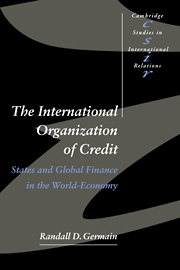Book contents
- Frontmatter
- Contents
- List of figures and tables
- Preface
- Note on figures and tables
- Glossary
- 1 Routes to international political economy: accounting for international monetary order
- Part 1 The international organization of credit in historical perspective
- 2 The power of cities and their limits: principal financial centers and international monetary order
- 3 Between change and continuity: reconstructing “Bretton Woods”
- Part 2 The contemporary international organization of credit
- Appendix: Top merchant/investment banks, by city and era
- References
- Index
- CAMBRIDGE STUDIES IN INTERNATIONAL RELATIONS
2 - The power of cities and their limits: principal financial centers and international monetary order
Published online by Cambridge University Press: 14 January 2010
- Frontmatter
- Contents
- List of figures and tables
- Preface
- Note on figures and tables
- Glossary
- 1 Routes to international political economy: accounting for international monetary order
- Part 1 The international organization of credit in historical perspective
- 2 The power of cities and their limits: principal financial centers and international monetary order
- 3 Between change and continuity: reconstructing “Bretton Woods”
- Part 2 The contemporary international organization of credit
- Appendix: Top merchant/investment banks, by city and era
- References
- Index
- CAMBRIDGE STUDIES IN INTERNATIONAL RELATIONS
Summary
Chapter 1 defined a world-economy as the set of relationships and practices that knit together a bounded social totality realized through the creation and diffusion of a certain kind of wealth. It considered the international organization of credit to be those networks of private and public monetary agents that stand at the heart of creating and channeling a world-economy's internationally mobile credit. In the modern period, these networks are rooted in the first instance in a world-economy's dominant city, where monetary agents are able to gain access to the financial resources which accrue to capitalists involved in commercial activities designed to accumulate wealth on a massive scale. Those cities that are home to these dense networks of monetary agents were called in Chapter 1 “principal financial centers,” or PFCs, in order to identify them as key access points to international credit. This chapter will develop our understanding of the role of PFCs in the construction of monetary order through a reconsideration of the relationships and practices that historically have served to constitute the international organization of credit. Central to this reconsideration will be the way in which the interaction of banking networks, state activities and the dynamics of wealth creation have shaped and directed the IMS from its inception in the sixteenth century to the end of the interwar era. Such a focus confirms the importance of viewing private monetary agents, international clearance, and the provision of long-term credit as critical dimensions of the IMS, and of the necessity of considering the international organization of credit to be thoroughly embedded within the larger social totality that is the world-economy.
- Type
- Chapter
- Information
- The International Organization of CreditStates and Global Finance in the World-Economy, pp. 33 - 74Publisher: Cambridge University PressPrint publication year: 1997



